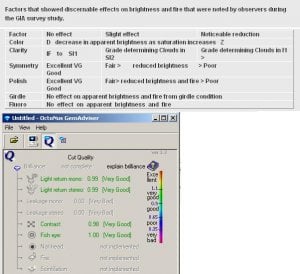Regular Guy
Ideal_Rock
- Joined
- Jul 6, 2004
- Messages
- 5,962
When I took business stats quite ago, I tried to make some wild eyed guesses about things, submitted it to my prof, and I never heard back. This may be like that. But...sorry guys...tracking the discussion for some time now, my mind is going here, and if anyone is interested in going here with me...I'd appreciate the help.
Initially, I'm just going for the lay of the land:
Requested: Feedback, of any kind you might like.
Observed: Gentlemen in some aspects of the trade have been the most vocal about variances from category I (i.e., Jonathans from GOG & WF, Garry, Paul...for example). Also, observed, not a lot of banter from our appraisers on these variances, no?
Target: 100% (In other words, if a future cut grade will be arrived at...it will have one single result...whether it's the new AGS0, or whatever, and so somehow, despite the fact that there are these many components that go into the beauty of a diamond, somehow, they'll need to be factored together into one whole result. Obviously, there are subtleties, and for Chess masters, computers may not do, and you just see the whole board. But...from the point of view of creating an expert system...you'll want to assess weights to the elements...as much as you can. So, your indulgence in tweaking this will make me delighted!).
I Relationship between crown & pavillion - 70%
a) taken as a whole, somehow, pavillion against crown has greater weight...70% to 30%? But is 100% of this imbalance due to the additional factor of the table size?
II a - Table size: 4.5%
b - Culet .5%
III - Facet construction - 10% (my bad...last night, I looked at the terms more closely presented in the tutorial here, and got a beginning glossary for a lot of the terms being used here, i.e., lower girdle facets, star, etc.
a) presume this includes yaw effects (another butchered concept...regrets in advance).
IV - girdle effects...whether cheated, gouged, etc. 10%
V - gases...non-iterated additional elements, without consideration to how inclusions will effect the beauty 5%
Once again, sorry. I'm a regular guy, and reading the board only this morning had me put in a 5% adjustment for the table. If this is actually spelled out better (I did a poor man's tour of teaching sites, including GOG, Nice Ice, and here before writing, but it was quick, my stamina is not what it used to be, and directing me back to another source that pulls this together may be what I need), let me know.
Thanks in advance for your indulgence,
Initially, I'm just going for the lay of the land:
Requested: Feedback, of any kind you might like.
Observed: Gentlemen in some aspects of the trade have been the most vocal about variances from category I (i.e., Jonathans from GOG & WF, Garry, Paul...for example). Also, observed, not a lot of banter from our appraisers on these variances, no?
Target: 100% (In other words, if a future cut grade will be arrived at...it will have one single result...whether it's the new AGS0, or whatever, and so somehow, despite the fact that there are these many components that go into the beauty of a diamond, somehow, they'll need to be factored together into one whole result. Obviously, there are subtleties, and for Chess masters, computers may not do, and you just see the whole board. But...from the point of view of creating an expert system...you'll want to assess weights to the elements...as much as you can. So, your indulgence in tweaking this will make me delighted!).
I Relationship between crown & pavillion - 70%
a) taken as a whole, somehow, pavillion against crown has greater weight...70% to 30%? But is 100% of this imbalance due to the additional factor of the table size?
II a - Table size: 4.5%
b - Culet .5%
III - Facet construction - 10% (my bad...last night, I looked at the terms more closely presented in the tutorial here, and got a beginning glossary for a lot of the terms being used here, i.e., lower girdle facets, star, etc.
a) presume this includes yaw effects (another butchered concept...regrets in advance).
IV - girdle effects...whether cheated, gouged, etc. 10%
V - gases...non-iterated additional elements, without consideration to how inclusions will effect the beauty 5%
Once again, sorry. I'm a regular guy, and reading the board only this morning had me put in a 5% adjustment for the table. If this is actually spelled out better (I did a poor man's tour of teaching sites, including GOG, Nice Ice, and here before writing, but it was quick, my stamina is not what it used to be, and directing me back to another source that pulls this together may be what I need), let me know.
Thanks in advance for your indulgence,












300x240.png)